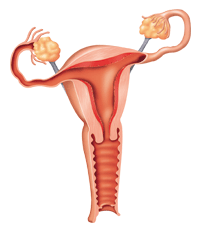During embryonic life the genital tract begins to develop from gonadal tissue (the gonads are the reproductive organs) at around about nine weeks gestation. Genes on the Y chromosome determine that development will produce a male. The absence of the Y chromosome means that development produces the female. The ovaries and testicles begin development high on the back wall of the abdomen, and migrate downwards, guided by a fibrous strand called the gubernaculum. The ovaries move only a short way and remain in the pelvis, while the testicles pass through the abdominal wall via a track in the groin called the inguinal canal and enter the scrotum. At birth boys should have both testicles in the scrotum. In girls the withdrawal of the maternal hormones may cause the production of a blood stained vaginal discharge, which indicates the presence of normal internal female organs. The female genital tract consists of the ovaries (which contain the egg cells and cells which produce hormones such as oestrogen and progesterone); the fallopian tubes (which provide a pathway for the egg between the ovary and the uterus, and where fertilisation usually occurs); the uterus, or womb (designed for the development of the foetus); the vagina (via which, under normal circumstances, sperm is introduced during intercourse to fertilise the egg, and via which the baby is born), and the vulva, which constitutes what’s called the “external genitalia” - the only part visible to most of us - consisting of two thin folds of skin called the labia minora, and two thicker, outer, hair-bearing folds called the labia majora. | |||
 | This information is licensed for use by Wellbeing Information Systems Ltd ("WIS"), and protected by international copyright law. All rights are reserved. (email info@wisinfo.co.uk). |

 - Tell me more about the female genital tract.
- Tell me more about the female genital tract.